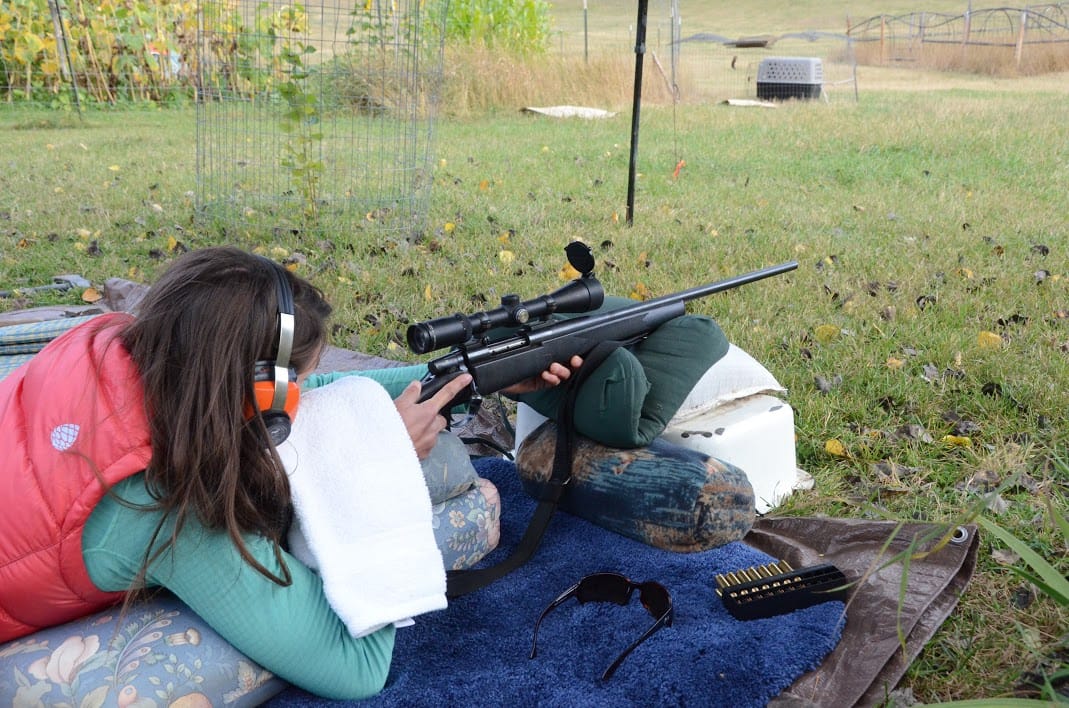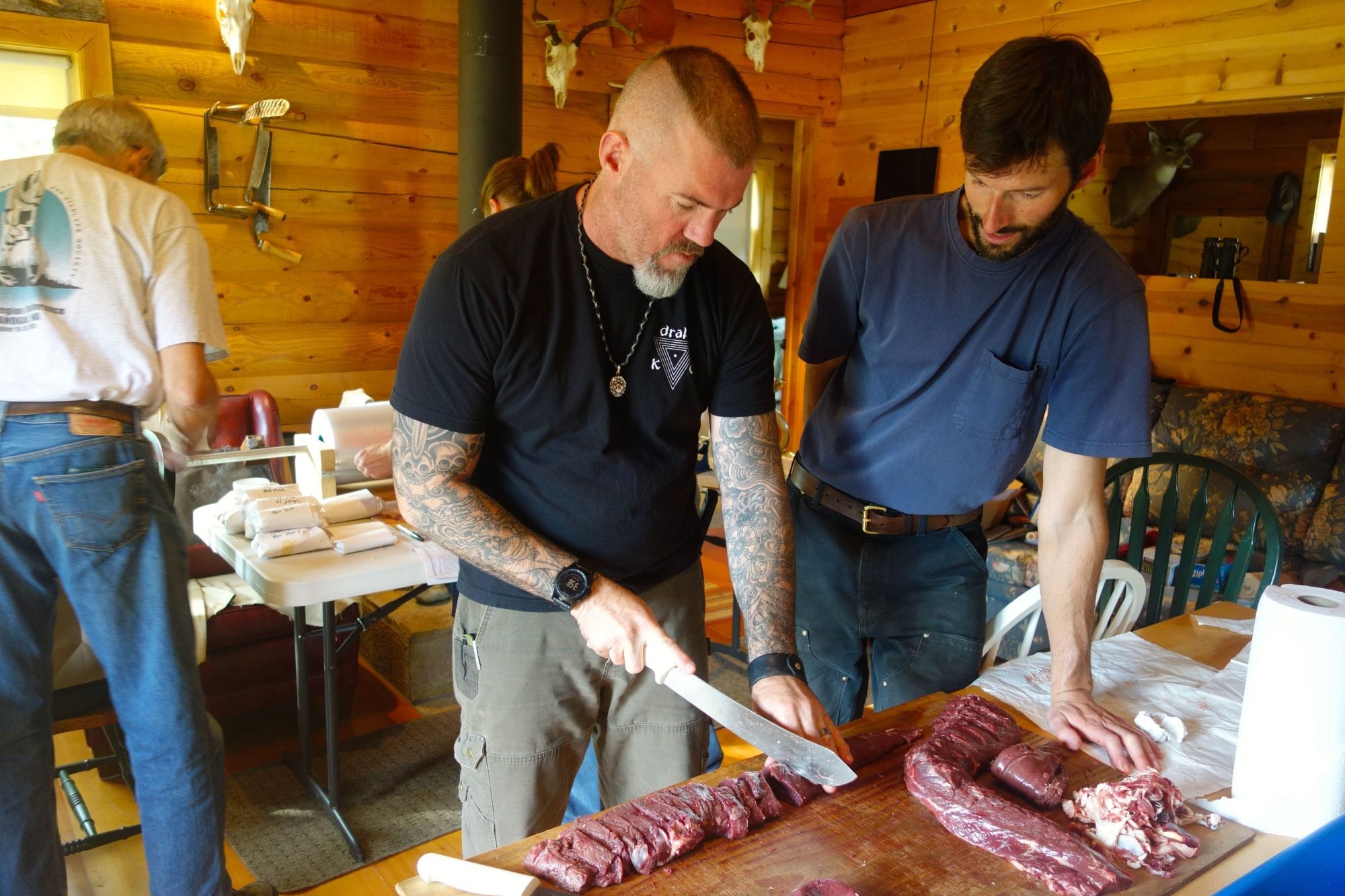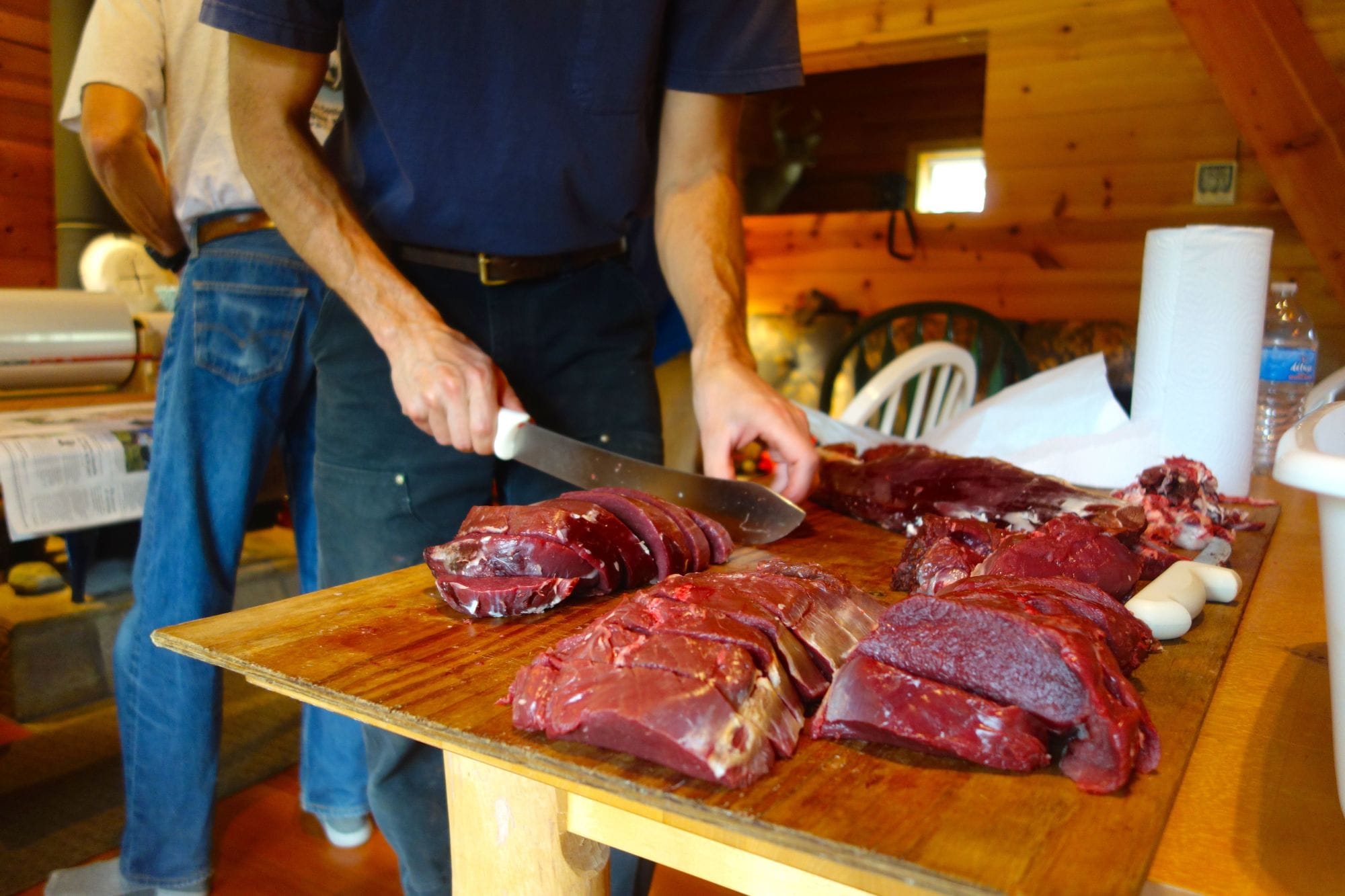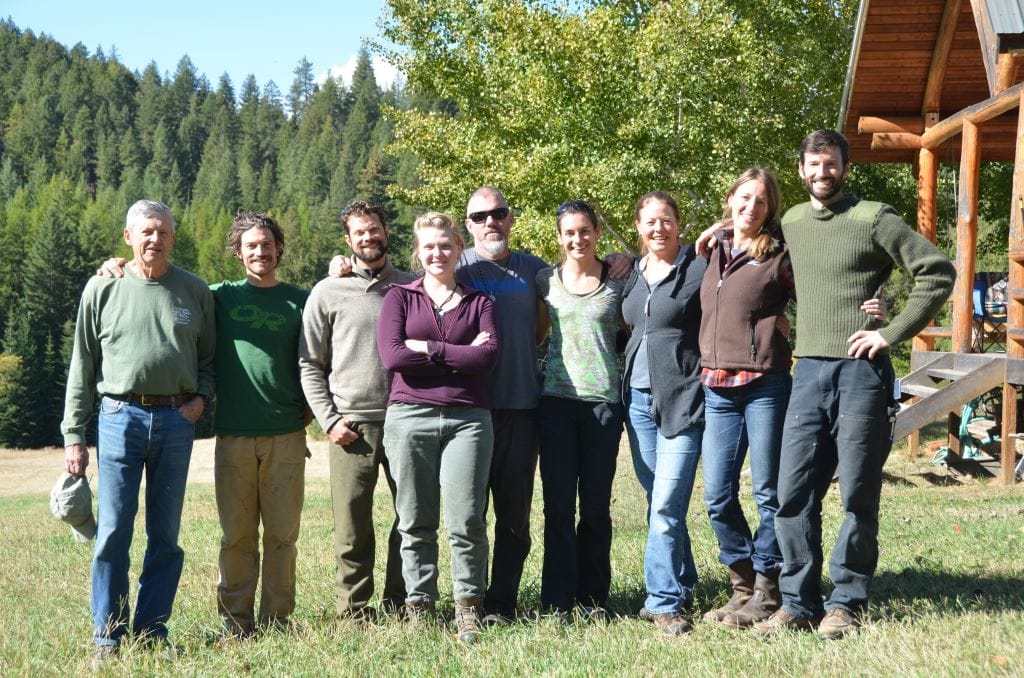Lying prone on the grass, I shuffle my elbows forward to position the rifle butt against my right shoulder. I close my left eye and focus my right on the viewfinder that’s a few inches in front of my face. The target wobbles within the lens as I take a breath; I let the air out and hold my lungs empty. My palms are sweaty as I float my index finger against the trigger. Fearing the recoil, I hesitate. But then my un-thinking brain kicks in — and I pull.
I flinch as the bang thuds against my eardrums, and the gun kicks against my shoulder. I pulled the trigger, I know, but it almost feels as though the gun is an independent, self-operating entity.
“That would be kill shot,” says Bruce McGlenn, kneeling next to me as he looks through his binoculars. A smile spreads across his face. I feel relieved, even proud. And then I try to contemplate what I would feel like had my mark been an animal rather than a cross inked onto paper.

McGlenn is my instructor for a four-day course in Kettle Falls, Washington, on the fundamentals of hunting. I made the six-hour drive from Seattle to the northeast corner of the state after seeing a Facebook post from McGlenn, an acquaintance with whom I’d gone on a group camping trip a couple of years ago, pop up on my feed advertising the inauguration of his new venture, Human Nature Hunting School:
Friends, Fellow Adventurers, Food enthusiasts: Are you looking for a deeper connection to your food and your land? Are you curious about what our ancestors experienced while in the hunt? Do you simply want to learn how to hunt and gather healthy, natural, organic, hormone-free, antibiotic-free, free-range protein?
Am I?, I wondered. My college diet of books by Michael Pollan and Eric Schlosser had once turned me into a vegetarian — which lasted a few years until my occasional meat cravings became more and more frequent and now I find myself a regular-burger-eating-carnivore. It did seem that, yes, perhaps I have been paying less attention to my food. And maybe I didn’t feel so good about that.
It wasn’t that I felt disconnected from nature. I spend most weekends climbing, running or otherwise playing in the mountains and islands and deserts that are within striking distance of my home Seattle. But my outdoor endeavors have always been much more Patagonia than Cabela’s. In fact, past encounters with hunters have given me a slightly uneasy feeling: When you’re a woman alone in the woods, meeting a man with a gun can be alarming.
Then again, perhaps this uneasy feeling was a misunderstanding, a manifestation of the fact that hunting just wasn’t part of the subculture from which I came. If I’m going to continue to eat meat, I thought, perhaps it was time to explore means of getting it that might better fit the value system of my more considerate former self. What I wasn’t so sure of was how that might resonate with the question still looming large in my mind: Would I actually be able to kill for my dinner?

Photo: Samantha Larson
Tall and lean, McGlenn has a somewhat inscrutable, bearded face, and speaks in a deep voice with a slow, contemplative rhythm. On the first afternoon of the course, he gathered his six students in a circle under the sun outside of his home, which he built himself on a large piece of property with a big grassy field and woods behind it. Then he talked about hunting.
“It’s not for everyone,” McGlenn said. “It’s a lot easier to go to the supermarket.” Still, he said, “It turns on these senses that I’m not normally using … a lot of times it’s like a walking meditation out there in the woods.”
We took turns introducing ourselves, and telling what brought us to the course. Robert and Nick, two friends who met in Buddhist seminary school, both wanted to experience a greater connection with nature and to edge closer to a lifestyle of living off the land. Erin left what she called an extremely polluted part of Southeast Texas to come to Washington and study at the Alderleaf Wilderness College. Beth recently quit her job in “corporate sustainability work” at a pharmaceutical company to search for work she might find more meaningful. Mark, a Seattle-based climbing guide with dreams of buying land in the Methow Valley and being able to hunt on it, would join us later that evening.
“I feel like there’s been an uptick in the awareness of hunting as something that’s good.”
It wasn’t exactly the macho, camo-clad crew that you might expect to show up for a weekend hunting trip. For some of the participants, defying the stereotype was even part of the draw: Beth said she got a kick out of watching her friends’ mildly shocked reactions when she told them she was going to learn how to hunt (I’ll admit to getting similar satisfaction).
McGlenn has been aware of the stereotypes and prejudices surrounding hunting for quite some time. He began perfecting his aim with a BB gun when he was 3 years old. He started bird hunting with his father when he was 9. He saved up his own money to buy his first rifle when he was 14, and shot his first elk the next year. When he started high school in suburban Bellevue, however, he soon realized that being a hunter wasn’t going to make him any friends. “There was one other kid in school who hunted,” he says, “and we didn’t talk about it.”
But with the rise of farmers markets and the local food movement, and increased scrutiny of the “industrial meat complex,” McGlenn thinks perceptions around hunting are starting to change. He started this course largely because of how often he’d been asked to share his expertise lately. A structural engineer in a former life, he says he “got tired of the office life.” Now, he hopes there’s enough interest in learning how to hunt and gather that Human Nature Hunting School could become his fulltime gig. “I feel like there’s been an uptick in the awareness of hunting as something that’s good,” he says.
The blood coming out of the dead doe’s mouth pooled atop the lush green grass. McGlenn had harvested the animal while we were setting up our tents. He obtained a damage control license from a local farmer whose alfalfa fields had reportedly become overrun with the deer munching on the crops. “I shot it, and it hunched up and walked for 20 to 30 yards, and then it buckled over about five seconds later,” he said. “A kill shot is over pretty quick.”

Photo: B.F. McGlenn
So far, my interest in hunting had been entirely theoretical. Now, the reality of it was really kicking in. The doe’s body was still visibly supple when McGlenn leaned into its flesh with his knife, revealing the hidden layer of muscle. Gut hook in hand, he then worked into the next layer, releasing a bloody, soupy mix as the intestines spilled out. We kept quiet while we watched McGlenn at work, explaining his process while he was doing it. He pulled out one lung — with a hole on each side from the bullet — and then the other. Then, the only thing left inside was the heart.
McGlenn paused and looked up at us. “Is everyone still OK?” he asked, with the trace of a slightly amused, apologetic smile.
I tried to fathom how, less than an hour prior, this animal had been alive and enjoying what it did not know would be its last meal. Now, its corpse was transforming into the meat we would soon be eating ourselves. The thought was a little overwhelming.
“Yeah,” we all murmured.

With the entrails cleaned out, McGlenn hung the carcass up on a set of hooks and gave us turns skinning. Bunching the still-warm flesh in one hand, I tugged down as I used a knife to guide the hide off the body. It sounded like tearing paper as the skin broke away from the thin layer of cotton candy-like connective tissue, exposing the deep-red muscles below. Erin began pulling the hide off the doe’s foreleg. “Just like a jacket sleeve!” she remarked. I grimaced.
At 9 p.m., an hour and a half after the whole deer had lain at our feet, the doe was disrobed and it was time to take a break from the butchering for the night.
After dinner in the house, I headed out to my tent. On my way, I looked over at the doe, a frame of striated muscle swinging from the hooks by its hind legs. It looked like a scene out of a horror movie.

It turns out, processing an animal as large as a deer is a big task. We spent most of the next day working on it. Little by little, the animal came apart into sirloin, steak, roast and a pile of meat for the grinder, giving us a reverse anatomy lesson in the process.
McGlenn’s father, John McGlenn, who drove up from Bellevue to help out with the course, supervised me as I pulled off the deer’s shoulder. “It’s not about killing, it’s about connection,” he told me as I cut through the flesh. By that point it felt like I had spent an awful lot of time with the doe. I wasn’t sure if I was feeling connected to it or just desensitized.
Still, I got what John meant. He talked with pride about his children — Bruce and his sister — and his three grandchildren, all of whom hunt. Hearing him talk reminded me of the hiking and climbing trips I took with my own dad.
But this was an entirely different way to experience nature than those trips I took growing up, or the ones I take today: Rather than busting in and out of the wilderness with a peak in mind, predominately focused on your own schedule, hunting requires a patience and awareness of the behaviors and patterns of other species and how they interact with the ecosystem as a whole. The hunter’s ideal is to blend in, to become an element of the forest, not simply to visit it. This, more than anything, was the philosophy McGlenn sought to embed within the course.

That sentiment came out in the first thing McGlenn asked us to do, after the introductions and before the arrival of the doe. He told each of us to find a place to sit in the woods and spend up to an hour just noticing what was around us — sounds, smells, sights, gut feelings — and write them down.
It sounded like a nice idea, but I had a story to turn in that evening, and since this was the only slot of unstructured time on our schedules, it seemed like that would be a better way to make use of it. So I decided to put the nature exercise off for the morning. I set my alarm for thirty minutes before breakfast, figuring that would give me enough time to take a few notes.
By that point it felt like I had spent an awful lot of time with the doe. I wasn’t sure if I was feeling connected to it or just desensitized.
The air was chilled, and the grass slightly frosted when I got out of my tent. Some of my classmates were gently rustling in their sleeping bags, and I could hear faint chatter coming from the kitchen. I walked a few feet down the trail from McGlenn’s house, and sat down. “Birds calling, frog croaking, stream running, a very slight breeze,” I jotted down in my notebook. “A temptation to check the time on my phone so as not to be late for breakfast.”
At the end of the course, we did this exercise once more, and then debriefed on it as a group. I listened to the observations of the other group members, about the exact species of the birds surrounding them, the possible motives behind the birds’ calls, the direction of the wind against their faces, and realized how shallow my own observations had been.
Perhaps it was the difference between dropping in and settling in. As Jim Posewitz, the conservationist and hunting ethicist who founded Orion: The Hunter’s Institute, writes in Beyond Fair Chase that this distinction is a fundamental part of what it means to be a hunter:
You need to be familiar with the field, the woods, the marsh, the forest, or the mountains where you hunt. If you work hard and long at this aspect of hunting, you can become a part of the place you hunt. ... Go afield often enough and stay out long enough and it will happen. Little by little you will become less of an intruder. More animals will seem to show themselves to you. You are no longer a stranger in their world; you have become a part of it.
As it turns out, however, there are no short cuts to this kind of understanding.
During the course, however, we got a good start. We got a lesson in gathering, learning where to look for edible plants, how to identify them and how to prepare them. We tried our hands at archery. We talked about the logistics of going for a hunt, including everything from how to get a license and tags to what to wear, tracking, hunting styles and some basic animal behaviors that could help us understand where to find them. We got the lesson in rifle shooting, and talked about how to track a blood trail to find the game should we ever actually hit one.
The last day began with more talk of ballistics and equipment. Then we rehearsed how to move through the woods while on a hunt — in other words, how to pay attention to your surroundings and move very quietly. We ended with an exercise like the one we started with, in which we spent some time sitting and taking notes on our surroundings: a practice in the patience and awareness required to be a successful hunter.

The house was warm when we went in for dinner on the last night of the course. McGlenn’s partner, Heidi, had cooked the venison. The beer, wine, laughter and conversation flowed as we passed around the plates stacked with various cuts of the meat we had all spent hours so painstakingly preparing.
I bit into the sirloin and let the juices ooze into my mouth. My expectations were high: Was this, as I so wanted to believe, the most delicious piece of meat I had ever tasted?
It was gamey and a bit chewy — good, but not exactly setting my taste buds on fire. Glancing back at the Wendell Berry quote that was taped onto McGlenn’s refrigerator, I allowed this thought to shift my perception: “A significant part of the pleasure of eating is one’s accurate consciousness of the lives and world from which food comes.”
Yeah, I thought. This is pretty damn delicious.

Still, while I had been more involved in the preparation of this meat than any other I had ever bitten into, I was aware that I still had not been the one who hunted it.
“To shoot, or not to shoot,” a 1999 entry from McGlenn’s hunting journal began. “That is the questions that goes through my mind more often than the average grocery shopper would care to imagine. All ethical hunters must make this decision at one point or another. There is absolutely no way to avoid it and certainly no way to undo it.”
In a class session, McGlenn told us, “You need to be ready mentally, psychologically and spiritually to take these shots. Don’t feel obligated to take the shot just because it’s there.”
Am I ready to take that shot? I still don’t know. As much as I like the idea of getting closer to my food, and the thought and consideration that goes into the art of hunting as McGlenn practices it, it still makes me really uncomfortable when I try to imagine looking down the barrel of a rifle with a living, breathing animal at the other end. Which raises the question: If I wouldn’t be able to pull the trigger, does should I be eating meat at all?
That’s a question I’ll have to spend some more time on, perhaps on my next walking meditation through the woods. Whether or not I bring a rifle with me, I’ll be listening a little more carefully, looking a little more closely, taking in more of the world I otherwise would have marched right past.


